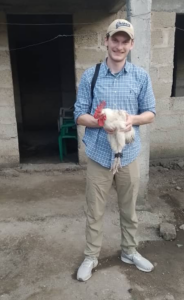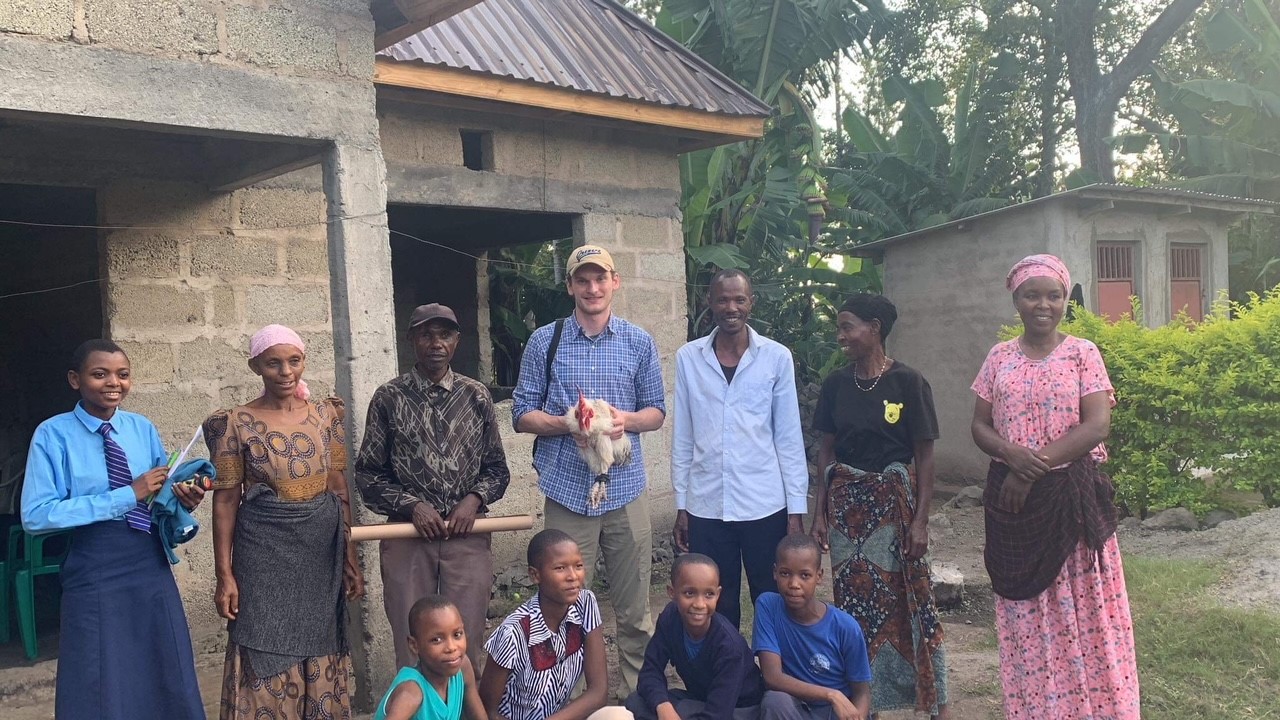Billed as the highlight of his year, NDY graduate engineer Beau Carner’s journey to Tanzania was filled with anticipation and a hint of serendipity. Originally planning to visit a family-supported girls’ school in Kitenga, a twist of fate led Beau to The School of St Jude.
The change of plan came about when Beau joined NDY, during an induction meeting where it was revealed that the company’s charity–The NDY Charitable Trust–sponsored two students at St Jude’s. With a trip to Tanzania already on the horizon, the timing couldn’t have been more perfect.
The School of St Jude offers more than just academic lessons; it’s a pillar of hope and embodies a community’s aspiration and resilience. Visiting the school was an opportunity for Beau to witness the impact of education abroad and also a chance to see how deeply integrated the school is within the local community. From suppliers who provide uniforms to those who feed the students, the ripple effects of St Jude’s reach far and wide, touching everyone involved.
Accompanied by his siblings, Beau’s visit became a family affair, underscoring the communal spirit that the school fosters. They were able to engage directly with students and teachers, participating in classes and even a house visit that brought them closer to the lives they were impacting. This firsthand experience highlighted not only the challenges faced in providing education in impoverished areas but also the profound impacts of sustained community support. Such encounters are eye-opening, serving as a poignant reminder of the broader significance of education in shaping futures, not just for the students but for the entire community.
Gemma Sisia, founder of The School of St Jude, sheds light on the impact of visitors to the school, saying, “we get over 1,000 visitors a year and the students love it.
“During COVID-19, we didn’t have visitors for 2 years and it was really hard. The kids really missed having visitors, they kept asking when they were coming back. Even people in town noticed the absence because no safaris were running. There were a few Australians who stayed at the school instead of returning home and the safari lodges were super cheap. So, I took a group of the girls who decided not to go back to Australia on safari. As we drove down a road near the national parks, everyone was clapping us as we went past, thinking we were the start of the return of all the tourists.
“And that’s what it was like with the students when the visitors started coming back, because they get to practice their English, they get to take the visitors home on a school bus, they get to take the visitors home to visit their family… so, imagine what your mum and dad would be like if the person who has paid for your entire education is coming? They feel very excited.”
Here’s some more about Beau’s Tanzanian adventure, in his own words.
Can you describe your first impressions upon visiting the school and meeting the children?
First, the school is very well developed. It was surprising to see how well equipped they are. Initially, I assumed that being in a developing country might mean the school would face some challenges with its facilities.
It is a large school. They have on site rooms for visitors to come and stay with them. Lots of classrooms. I think the only thing that was ostensibly lacking was perhaps some of the technology we’re used to in developed countries.
Meeting the kids for the first time was an amazing experience. I’m sure they get plenty of visitors, but it made my day to see them all bubbly and happy to see us and they were all trying to flex their English, or the limited English that they knew.
How does their approach to education and support for children in poverty differ from other initiatives you’re aware of?
They have an established system for reaching out to the impoverished communities that many of their students come from. When we met Gemma Sisia, the founder, she ran us through their approach.
Basically, they’re not just looking for the most gifted students, but also the students in the worst financial position. It was amazing to hear about the effort that goes into their search, with teachers and some past students actually driving out to these remote villages where there are poor children, to reach out and invite them to undertake thorough testing that includes multiple entrance exams. And the kids all study for them with material given to them by St Jude’s.
It was inspiring to see the emphasis on getting exposure within these remote communities and reaching the children who really need their help.
Can you share a story about one of the children you met and how the school has impacted their life?
The student I spent the most amount of time with was Vanessa. She’s one of the two students sponsored by the NDY Charitable Trust, and St Jude’s had organised a house visit at the end of our tour of the school.
We spent a few hours partaking in different classes and eating with them and then took a bus out to Vanessa’s house to meet her parents and her extended family.
It was an amazing experience.
She was so thrilled to meet us, though I think she didn’t quite understand that I wasn’t her direct sponsor, but rather representing NDY. So, a bit of imposter syndrome there for me!
Vanessa was incredibly grateful, and once she opened up to me and my sister (who was with me) then she was happy chatting about her favourite subjects and how she loves going to school. And that now she’s living on site she can avoid the commute from her house, which is over an hour’s drive away. She loves living in a boarding house with other girls and raved about how fun it’s been.
She’s really appreciative of the opportunity to have an education and, as you’d expect, her parents were infinitely grateful for the opportunity of their daughter getting to go to St Jude’s and unlocking future opportunities for her.
In what ways has visiting Tanzania and other areas of Africa changed your perspective on education and poverty?
It’s very multifaceted and has opened my eyes to the difference in mentality behind education and why you want your children to be educated in places like St Jude’s. It’s a life changing experience.
If you don’t get the opportunity to go to a private school, your education will end at our equivalent of middle school. And then you’ll likely be doing some form of manual labour or agricultural work for the rest of your life. Whereas if you are one of the lucky students that gets to go to a private school, the opportunities that are presented to you are almost infinite.
The biggest eye-opener was to witness the level of sacrifice the students and families endure to pursue basic education. You’d see parents working non-stop just to get a child through middle school. This was a stark contrast to Australia, where primary and secondary education is generally viewed as a right and not a privilege.
The other key takeaway was how crucial community support is for the success of education in impoverished communities. It was incredible to see how community members and alumni would volunteer to help local schools, so that kids can seize an opportunity they likely never had.
What were some of the challenges you observed the school facing in providing education and support?
The big one is that they have a limit on how many students they can accept. I guess that’s the same for any school. But for St Jude’s in particular, there’s a really high demand from parents and communities to get kids enrolled.
How did the children and the community react to your visit?

As I said earlier, the kids loved it. The first thing I noticed as soon as we got off the bus and entered the school was the kids giggling and looking at us (like we were from a different planet). But once we sat down and ate with them and then joined in their classes, they really opened up. They probably loved it more than we did!
And meeting the community was something different entirely. Especially during the house visit, the extended family came around to say hello. It was a big deal to have visitors in their town.
We started with Vanessa and her parents, then were joined by her uncles and aunties. We also met her friends from down the road that go to a government school, they were telling me about it in the best way they could (in broken English). They were telling me what their favourite subjects were and how many days a week they go to school and things like that.
It was interesting to experience the impact on the community, that our visit was a coming together and a big event. They were very hospitable; they fed us and encouraged us to eat yummy doughnuts they made in their homes. The community also gifted us a chicken when we were leaving! It was a generous gesture. Thankfully, the St Jude’s team took it back to the school and gave it to one of the students in their welfare programme, so it went to a family that’s struggling.
What is something you learned from your visit that you didn’t expect?
A tough question. Lots of things. If I have to choose one, I guess from the Saint Jude’s perspective it’s how beneficial it is to have a well managed school in that sort of impoverished community.
I would attribute that the success of St Jude’s comes down to Gemma and the people that work with her, and their management at the school. There’s so much going on behind the scenes, it’s a sophisticated system of management to keep the school running at its best. While there’s not a lot going on in Tanzania, the school was probably better managed than my school in Melbourne!
What message would you like to share with others about supporting such charities?
I would simply say it’s good to get involved. You don’t necessarily have to advocate or contribute financially, but gaining an understanding of what the actual charity is and who it impacts will definitely change your perspective and probably make you want to support it more.
Then if the opportunity comes up, put your hand up and get involved.
Has this visit helped you better appreciate the other charities the Trust supports?
Supporting a charity is always appreciated, but it’s different when you see the work firsthand. Experiencing the tangible impacts and the broader ripple effects of the charity’s efforts provides a deeper understanding that goes beyond what’s listed in brochures. While I would still value those charities without this exposure, witnessing their work directly has definitely enriched my appreciation in a unique way.
Before we go, what was your favourite part of visiting The School of St Jude?
There were countless highlights, but the house visit stands out as the most enlightening and enriching experience. It’s an aspect of the trip that will stay with me for a long time. Another remarkable part was the warmth and openness of the people. Everyone was incredibly welcoming, eager to stop and chat, genuinely interested in connecting. This sense of community was starkly different from the often busy and impersonal interactions we are used to in more developed countries. It’s not just living alongside others; it’s about truly knowing your neighbours. It was a lovely experience, one I’d highly recommend.


